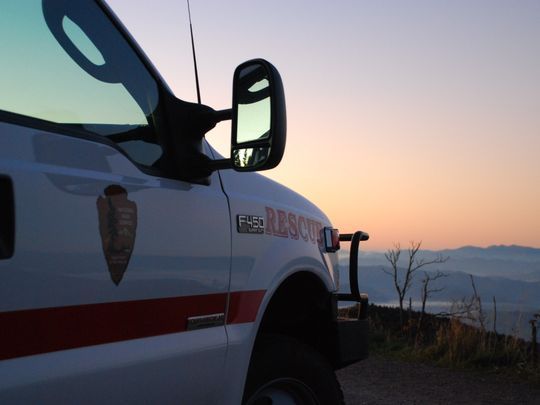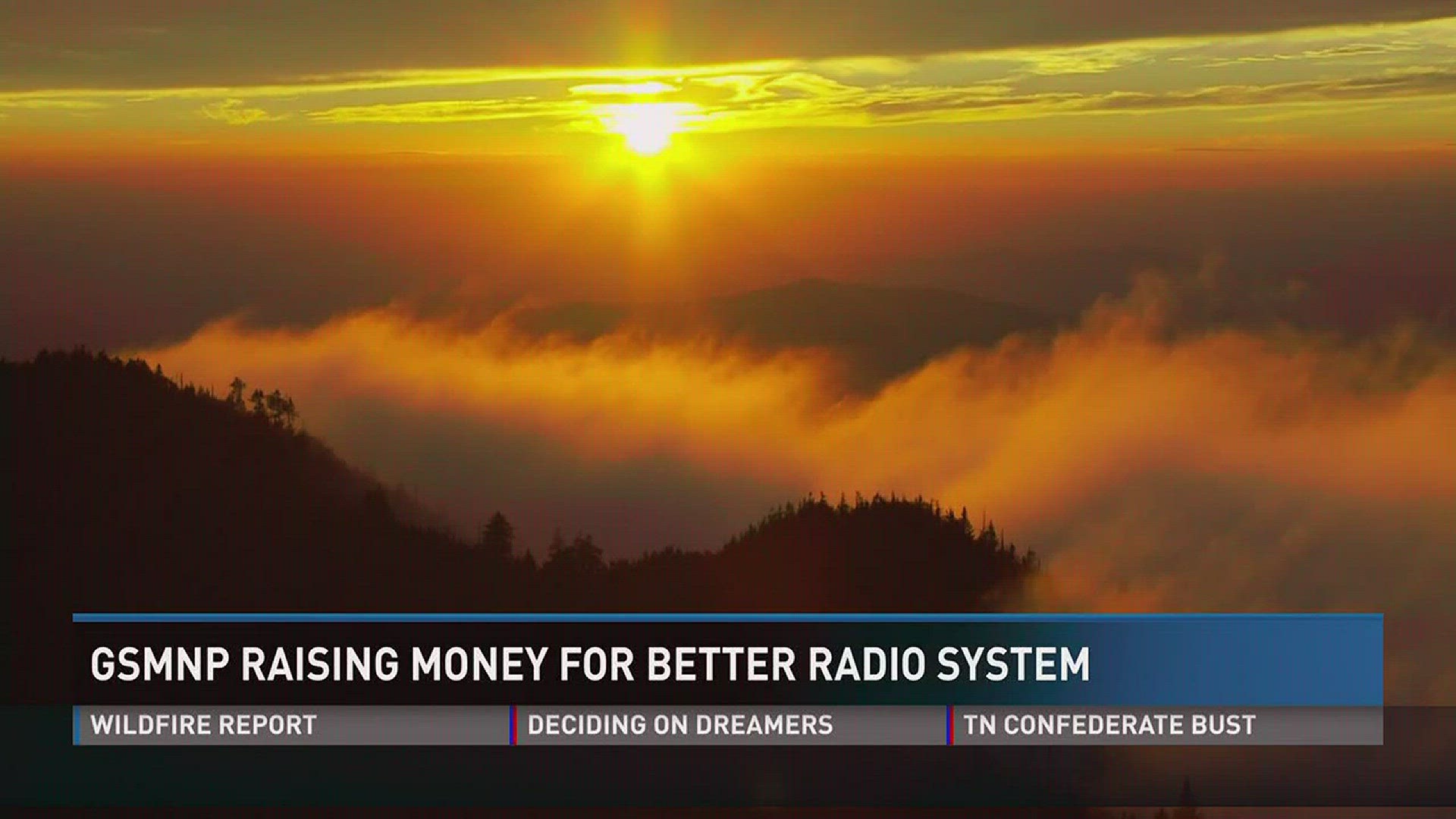This year, #GivingTuesday has fallen on the same day as the first-year remembrance of the Sevier County wildfires. What better way to give back today, then, by funding a critical upgrade for the Great Smoky Mountains National Park to help keep park visitors and rangers safe in the future?
The GSMNP and Friends of the Smokies are trying to collect $1.25 million to fund much-needed upgrades to the park's aging emergency radio system. The Friends group said each gift it receives will be matched dollar-for-dollar, so if it reaches the goal that means $2.5 million will be donated to the park for that upgrade.

If you are hiking in the Smokies, you've probably seen the donation boxes at certain trail heads. You can donate right now to help fund the upgrades by clicking this link.
The new system will upgrade outdated and aging equipment in the park that are well beyond the equipment life expectancy, including new handheld radios for rangers, mobile repeaters and antennas. The upgrade will also rehabilitate nine repeater stations with computer-aided dispatch responders to ensure communications are not easily interrupted or delayed-- one of the major problems noted in the review of how the park handled the 2016 Sevier County wildfires.
The annual Friends Across the Mountains telethon on Aug. 24 raised $208,321 for the campaign.
"This is the second-largest project we've done in our 25 years," said Jim Hart, president of Friends of the Smokies. "This project could not have come along at a more important time. The fact we can raise some of the funds for this and it was just underlined by the results from the [wildfire] study, it's good timing to help people realize the importance of this campaign."
According to the Asheville Citizen-Times, the dispatch system will be used to prioritize and record incident calls, identify the status and location of responders in the field, and dispatch responders.
The upgrade will allow park rangers and emergency dispatchers to directly communicate with police, fire and emergency services in jurisdictions outside the park, including agencies in North Carolina and Tennessee.
The communications system revamp carries a price tag of $2.5 million -- $1.2 million for work on the nine radio repeater infrastructure and the remaining $1.3 million for mobile radio units, handheld radio units, and the dispatch system. If Friends of the Smokies reaches its goal, that price tag will be paid off in full.
The park's maintenance backlog has reached $211 million, spokeswoman Dana Soehn said. Deferred maintenance includes repairing and rebuilding roads in the more than 80-year-old park, rehabilitating buildings and upgrading wastewater facilities.
The Friends group turns 25 this year and over its history has raised $57 million for Smokies projects, including the establishment of the Trails Forever endowment to permanently fund a dedicated Smokies trail crew, rehabilitating the Alum Cave Trail to Mount LeConte, and construction of the Oconaluftee Visitor Center in Cherokee.
Bake sales for radios and road construction?
That a federal agency would have to turn to the public to buy life-saving equipment with money from bake sale- type fundraisers is a result of shrinking budgets.
But the fundraisers are essential in keeping the park running, as budgets and staffs have remained stagnant over the past decade, even though visitation continues to increase, and aging infrastructure continues to deteriorate, Soehn said.
The park’s annual budget is just under $19 million.
“We compete across the National Park Service for line-item and repair proposals. We’re competing with other parks for funds because our operating budget is not able to support these projects,” she said.
“We supplement our needs through Friends of the Smokies and the Great Smoky Mountains Association. We get about $1 million from each of them each year.”
Other funding sources come through donation boxes throughout the park and about $600,000 annually from Smokies specialty license plates fees.
There is no entrance fee to the Smokies. The heavily forested park includes hiking trails, waterfalls, campgrounds and picnic areas, historic sites and wildlife including black bear and elk.
Soehn said the park, which received more than $11.2 million visitors in 2016, also relies on a volunteer force. The park has a permanent staff of 150, and 100 seasonal employees who work during the busy height of summer and early fall. In contrast, 2,802 volunteers help keep the park running.
“Without the volunteers and our partners, we couldn’t function as a park,” she said.
Deferred maintenance is a growing crisis across the more than 400 units of the National Park Service, from the Smokies, the Blue Ridge Parkway and the Carl Sandburg Home in Western North Carolina, to the Statue of Liberty and the great Western parks such as Yosemite and Yellowstone.
According to National Park Service report, in 2016 maintenance backlogs totaled $11.3 billion.
Addressing the backlog is a top priority for the National Park Service, said Saudia Muwwakkil, NPS spokesperson for the Southeast Region in Atlanta.
National parks, visitor safety at risk?
In the Smokies, repair of 384 miles of roadway, to the tune of $147 million, ranks as one of the biggest maintenance needs, Soehn said.
Old age and heavy use of roads are not the only culprits. The park’s high elevations receive large amounts of ice and snow in the winter causing freezing and thawing, leading to potential landslides.

Facilities and buildings are also in need of major facelifts. The wooden headquarters building in Gatlinburg is more than 75 years old and has a $5 million repair backlog to restore the structure and its heating and cooling system, Soehn said.
Sugarlands Visitor Center, built in the early 1960s and home to a popular museum, also needs upgrading.
The Blue Ridge Parkway, a 469-mile roadway slicing through Asheville as it connects the Smokies with Shenandoah National Park in Virginia, has had to defer maintenance. It is the most visited unit of the National Park Service, drawing 15.2 million people last year.
The parkway also relies on funding from partner groups including the Blue Ridge Parkway Foundation and Friends of the Blue Ridge Parkway. The biggest need is road repair. Several rock slides have caused closures on the parkway over the past few years, including a road washout in October near Asheville.
“The grounds, utilities and buildings are also in need of repair,” said parkway spokeswoman Leesa Brandon. “As infrastructure continues to age and the cost of business grows, the gap widens.”
As of now, the parkway’s radio fleet is in good condition, said Mike Molling, parkway chief of maintenance and engineering.
The parkway has 240 vehicles, used for maintenance and other divisions. All of the 35 law enforcement vehicles have portable radios, which are replaced as needed, but no longer than 10 years, Molling said.
“No portables or mobile radios are in danger of dying,” Molling said.
But the Smokies’ radios are in actual danger of dying.
“Some of my law enforcement patrol cars out of Gatlinburg have three different radio frequencies and work with Pigeon Forge and Blount County. The new radios will combine all three to improve communication,” Kloster said.
He has roughly 37 vehicle radios, 42 portable, or handheld radios, five fire engine radios and six portables.
“Luckily we have not had any life or death type incidents in which a ranger was in need of backup. One tried to call and realized the radio not working. It just stopped functioning in the middle of a shift. When that happens, they have to swap it out or ride with someone else,” Kloster said.
“The repeaters, which link North Carolina to Tennessee have also gone down. This has happened several times before, luckily not in the middle of a major emergency,” he said.
Kloster said the aging radios were not a factor in the November 2016 wildfires that started on the Chimney Tops Trail and swept into Gatlinburg, Tennessee, killing 14 people. The city and the park have been widely criticized for inefficient notification and response to the fatal fires. Rangers met face-to-face with Gatlinburg officials during the fire, Kloster said.
“Whatever goes on in your hometown, goes on in the park, just at different levels. We have motor vehicle accidents, murder, rapes, domestic abuse,” Kloster said.
Last year there were 250 motor vehicle accidents, 100 search and rescues and 75 DUIs, as well as citations for drug possession and speeding, he said.
“Just because there’s not a lot of violent crime doesn’t mean it’s Mayberry. We arrest a lot of people on felony warrants. It only takes one time for things to go bad. We work in a lot of remote areas, by ourselves, so the radio is the key."
The outdated communications system in the Smokies is unacceptable, said Phil Francis, a former superintendent of the Smokies and the Parkway. Now retired, and living in Asheville, he is a member of the Coalition to Protect America’s National Parks.
The nonprofit, advocacy group consists of former, current and retired Park Service employees.
Parks used to use appropriated funds to pay for equipment, using money from Friends’ groups as “the icing on the cake,” Francis said. But appropriations have been cut so many times, nonprofits have been taking over operational needs.
“ When we get to the point of having to replace something that is a critical need and through donated funds, it’s truly disturbing. To me, it’s the role of the Congress. It seems the budget cuts have gone too far.”

